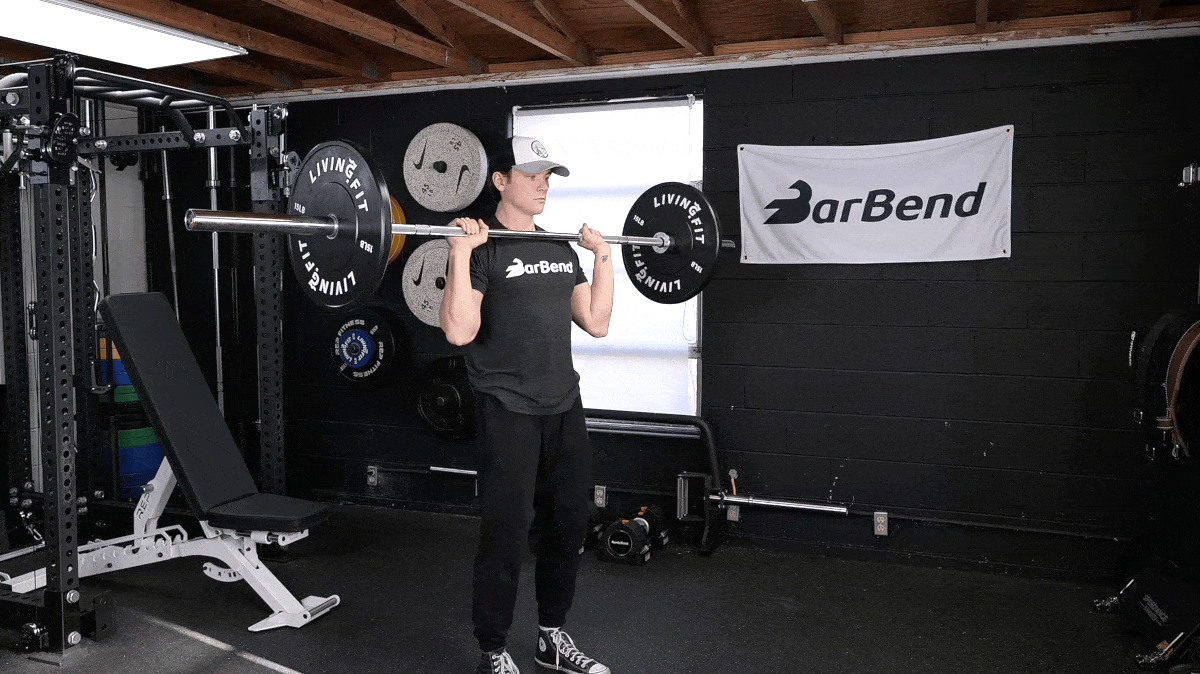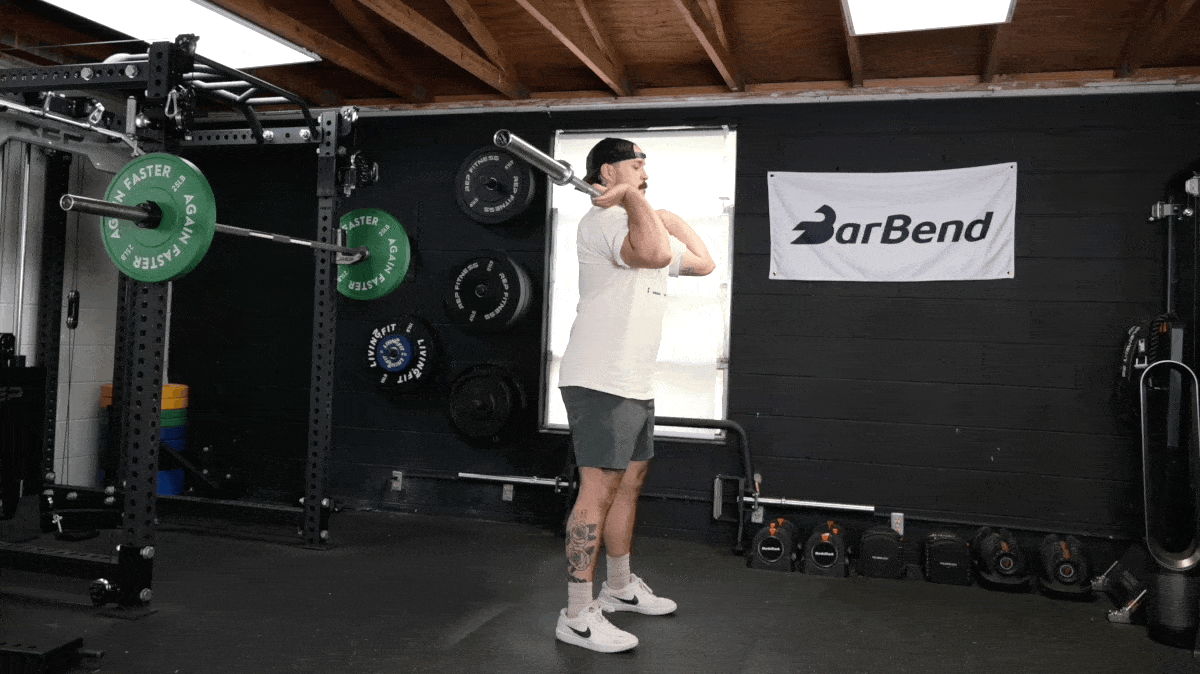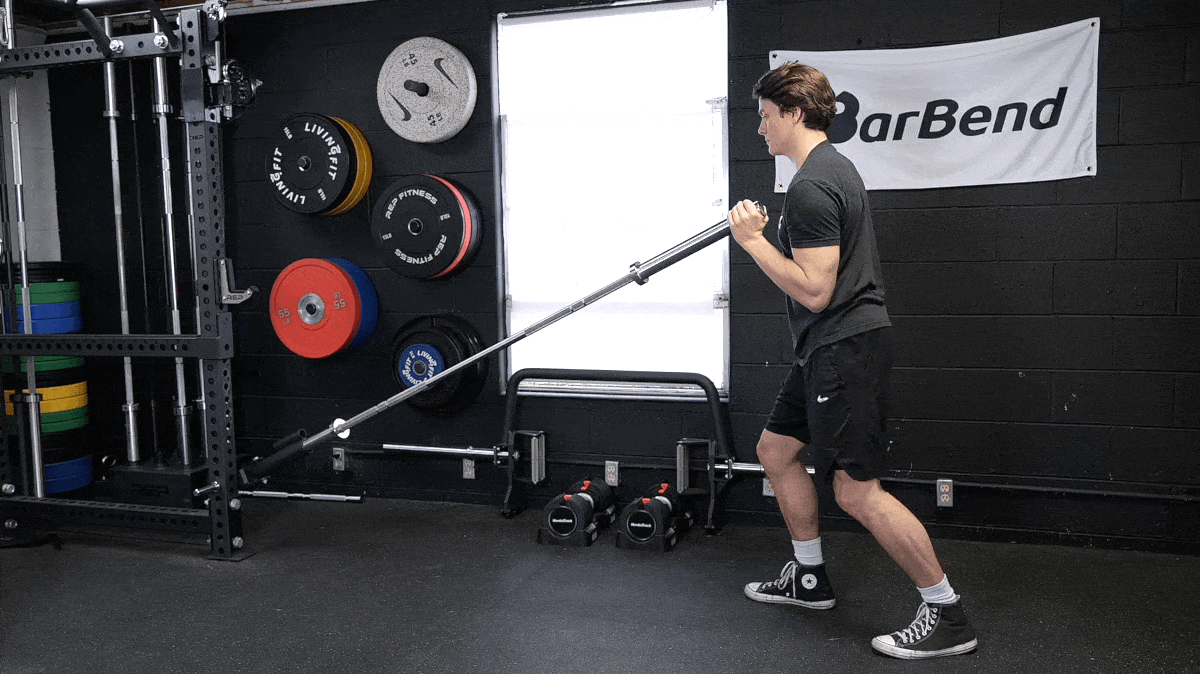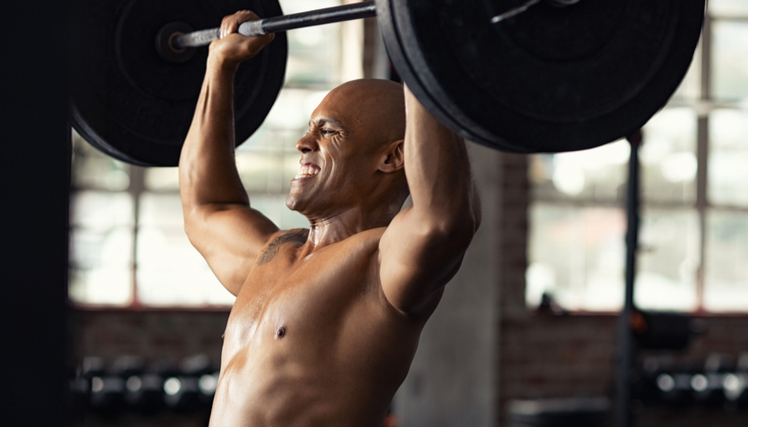Whether you’re a powerlifter, strongman, weightlifter, a CrossFitter, or bodybuilder, you know about the big three; the bench press, deadlift, and squat. There is, however, one more movement that you should consider a must-do — the overhead press. A staple in every strength sport, the overhead press has more aliases than Danny Ocean.
You may know it as the shoulder press, strict press, military press, or standing press. Whatever you call it, the benefits remain the same: more upper-body strength, specific carryover to various strength sports, and bigger shoulders. Here’s how to do a proper overhead shoulder press, plus all of its variations and benefits.
Editor’s Note: The content on BarBend is meant to be informative in nature, but it should not be taken as medical advice. The opinions and articles on this site are not intended for use as diagnosis, prevention, and/or treatment of health problems. It’s always a good idea to talk to your doctor before beginning a new fitness, nutritional, and/or supplement routine. None of these supplements are meant to treat or cure any disease. If you feel you may be deficient in a particular nutrient or nutrients, please seek out a medical professional.
Video Guide
Check out this video tutorial on how to perform the overhead press — performed by Jake Boly and coached by strength coach and strongman Joey Szatmary.
[Related: The Best Pre-Workout Supplements for Muscle Gain, Weight Loss, and More]
How To Do the Overhead Press
Below is a step-by-step guide on how to perform the overhead press using a barbell. Bear in mind that this exercise is sometimes called the “military press”, categorized by placing your feet under your hips in contact with each other.

[Read More: 5 Overhead Press Benefits]
Equipment Needed: You’ll need a barbell and some weight plates. If the bar gets heavy enough, you might want to also use a squat rack to hold the barbell at shoulder level.
- Step 1 — Set a barbell in the J hooks of a power rack so that the bar is level with your upper chest. Set your hands on the barbell so that they’re slightly wider than shoulder width apart. You want the barbell to sit in the meat of your hands, or palms.
- Step 1 — Unrack the barbell, keeping your wrists stacked over your elbows, and your elbows tucked in. Take two steps back from the rack and set your feet are roughly shoulder-width apart.
- Step 1 — Press the barbell by tilting your head back and pushing it upward and slightly back. Once the barbell passes your head head, continue extending your elbows while pushing your head “back through” to a neutral position.
Coach’s Tip: The overhead press isn’t a glute exercise, but you should still contract your buttocks to stabilize your hips.
Overhead Press Variations
The overhead press is a highly technical movement and shouldn’t be taken lightly when first learning its form. To help progress you to perfect presses, we recommend working with some overhead press variations below.
Dumbbell Overhead Press
[Read More: 10 Overhead Press Commandments]
Why Do It: The overhead press with dumbbells is a great first option for learning the overhead press. Dumbbells are slightly easier to work with when it comes to nailing the overhead press form and joint sequencing. The dumbbell press is also a good option if you feel intimidated by the barbell or don’t have access to one.
Equipment Needed: You’ll need an adjustable bench or a low seat as well as a pair of dumbbells.
- Sit up against a bench or low seat with a pair of the best dumbbells resting on your knees.
- In one swift motion, “kick” the dumbbells up one at a time to shoulder level and hold them with your arms bent and your elbows pointed to the sides.
- Inhale, brace your core, and push your upper back against the bench to stabilize your body.
- Then, push the dumbbells up and inward until your arms are parallel and pointing directly at the ceiling.
Push Press

[Read More: The Differences Between the Push Press Vs. Overhead Press Explained]
Why Do It: Push presses are a weightlifting accessory exercise, but you can do them to improve your overhead stability or to add some extra power to your standard shoulder workouts. Push presses also involve your legs to a degree, so you can somewhat consider them a full-body movement.
Equipment Needed: You’ll need a barbell and, ideally, bumper plates in case you need to drop the bar quickly.
- Stand upright with the barbell held in the front rack position and your feet under your hips.
- Inhale, brace your core, and then slowly sink down into a high quarter squat position.
- Rapidly change direction, driving your legs hard into the floor.
- Fully extend your hips, knees, and ankles in one motion to push the bar off your shoulders without relying on your arms.
- As the bar leaves your shoulders, tilt your head backward out of the way and allow it to fly past your head.
- Once the bar has cleared your head, engage your triceps to extend your arms and lock the bar out overhead.
Shoulder Pin Press
[Read More: Avoid These 5 Common Overhead Press Mistakes]
Why Do It: This overhead press variation is done in a squat rack with a barbell resting on pins at the chin level. The starting height can vary based on the sticking point of your overhead press or area of weakness. This is a good way to develop concentric strength, address sticking points, and overload a specific angle for increased strength or emphasis on a muscle.
Equipment Needed: You’ll need a barbell and a squat stand or power rack with adjustable safety arms to hold the bar at a certain height.
- Set a bar up in a squat rack with the safeties adjusted such that the bar rests at roughly eye level or even slightly above.
- Situate yourself under the bar and grip it with your normal pressing grip.
- Brace your core and push the bar off the safety arms to a locked-out position overhead.
- Lower it back down slowly with your normal technique until it comes to a stop on the safeties once again.
Overhead Press Alternatives
Below are three overhead press alternatives that you can do to increase strength, power, and hypertrophy or add variety to your workout routine.
Landmine Shoulder Press

[Read More: Seated vs. Standing Shoulder Press: How to Know Which One Is Right for You]
Why Do It: Outside of performing the overhead press with dumbbells, the landmine press is another fantastic shoulder press variations for accumulating more volume. This variation is fantastic because it loads the shoulder joint differently from the directly overhead axial (on-the-spine) loading that comes with the standard overhead press.
Equipment Needed: You’ll need a barbell and a landmine fixture for this one. Or, you can wedge the end of a bar into the corner of a room.
- Set a barbell into the landmine attachment or the corner of a room and load it with weight if desired.
- Stand facing the free end of the bar and pick it up with your working arm. Hold it at shoulder height with your upper arm bent and tucked against your torso.
- Press the end of the bar up and away from your body.
Z Press
[Read More: Z Press vs Overhead Press – Which Is Best for Strength and Sport?]
Why Do It: The Z Press is a seated overhead press with dumbbells (or kettlebells or a barbell) that targets the upper body pressing muscles, along with the core and hips. Since you’re in a seated position while performing the Z Press, the body has to work exceptionally hard to stabilize itself for success. If you’re trying to improve hip mobility, core strength, and pressing mechanics, then employ the Z Press into your shoulder workouts as an accessory.
Equipment Needed: You’ll need a barbell and a power rack with adjustable safety arms or J hooks.
- Set the hooks of a squat rack (or the safety arms) at about eye level if you were sitting down on the floor, then place the bar on the hooks or safeties.
- Sit on the floor with your legs extended in front of you and grab the bar with your normal pressing grip. It should be very close to your face.
- Inhale, brace your core, and maintain a tall torso. Then, press the bar off the rack to an extended position over your head.
Who Should Do the Overhead Press
The overhead press isn’t for everyone, but it almost is. If you’ve been sold on the movement, double check to make sure you fall into one of these categories before you make a run for the squat rack.
Strength and Power Athletes
Strength and power athletes use the renegade row to increase shoulder and upper body strength, muscle hypertrophy, and scapular stability. Powerlifters can use it as an accessory to develop their bench press, while Olympic lifters and strongmen both take weighted implements overhead all the time as part of their sport.
As such, working the overhead press, especially with a barbell, is a great way to mimic the demands of your competition movements.
General Populations
For the same reasons listed above, any gymgoer can benefit from this movement. The overhead press will add more mass to your shoulders (if that’s your goal), improve any other pressing movement in your repertoire, and enhance your ability to reach overhead, which is a basic movement pattern that you engage in daily.
Bodybuilders
If you aspire to look better — or step onto a bodybuilding stage — at some point, you’ll need big shoulders. They cap off your torso and help improve your v-taper, so you should probably have at least one form of vertical press in your bodybuilding workout plans.
You may not need the standard, standing barbell version of the press, but it’s always a safe jumping-off point.
Overhead Press Sets and Reps
The press is versatile. You can use it to build upper body strength, beef up your shoulder muscles, or help you prepare for any real-world task life throws at you. As such, you need to ensure that your programming matches your goal. Here are a few different ways to implement overhead pressing.
- To Gain Muscle Mass: 3 to 4 sets of 6 to 8 reps, at a moderate rate of perceived exertion.
- For Max Strength: 5 to 8 sets of 3 to 5 reps, with at least two minutes’ rest in-between.
- As a Beginner: 3 sets of 5 reps, with a light weight and strong focus on your technique.
Benefits of the Overhead Press
There are a ton of reasons why you should be overhead pressing regularly. Below are four of the many reasons why the overhead press should be a staple in your workout program.
Upper-Body Strength
In general, the overhead press is one of the best movements for obtaining upper body strength as a whole. Compared to other pressing movements, the overhead press will target the most muscles, translating to total body pressing strength. Outside of hitting the prime movers (the deltoids), the overhead press will also hit a plethora of stabilizers and synergist muscles.
Most Bang for Your Buck
If you’re tight on time and need to cut your workout short, the overhead press should be at the top of your list. Since this movement targets so many muscles, it’s a great option for lifters that want the most bang for their buck at the gym. As opposed to isolation pressing exercises which can be limited in nature, the overhead press has a much higher ceiling for total growth and progression.
In short: Why target just your shoulders or triceps when you could hit your shoulders and triceps (and chest and upper back) with one movement?
Application to Strength Sports
If you compete in strength sports, especially strongman, weightlifting, and CrossFit, then you should be overhead pressing — even powerlifters can benefit from overhead pressing in their off-seasons. This movement will have carryover to total body strength when moving barbells overhead, a must for nearly every strength sport.
Muscles Worked by the Overhead Press
The below muscle groups are strengthened and trained during the barbell overhead press. Many of the same muscle groups are also targeted when performing the overhead press with kettlebells and dumbbells.

[Read More: The Untold History of the Overhead Press]
One small difference that comes with the overhead press than isolation exercises and other pressing variations is that it can be a fantastic movement for passively targeting the core. Though they’re not mentioned below, the quads, glutes, and core muscles will all need to work to stabilize the body when moving weight from a dead stop position to overhead.
Shoulders (Deltoids)
The shoulders are the primary muscle group used when performing overhead pressing, specifically the anterior head of the deltoid.
Triceps
The triceps are responsible for elbow extension during the pressing movements. The triceps become more involved at later stages of the overhead press and aid in elbow lockout of the overhead press.
Upper Pecs
The upper pecs assist the shoulders and triceps in the pressing of the weight overhead, specifically during the initial phase of the lift. The greater degree of back extension (leaning backward) in the setup, increases upper pec usage (similar to that of an incline barbell bench press)
Scapular Stabilizers
Overhead pressing is dependent on scapular stability muscles to help create tension to support the shoulders, triceps, and upper pecs.
Proper shoulder stabilization will also help position the barbell properly overhead and minimize injury compared to a more unstable scapular position.
Common Overhead Press Mistakes
The overhead press is a movement that comes with a lot of small moving parts, so here are a few do-nots to keep in mind as you’re executing the movement.
Pressing Around the Head
The first overhead press mistake lifters can run into is pressing around the head, which is when one shifts the bar path to accommodate one’s head position. Typically, shifting the bar path means the joins won’t be stacked, and if they’re not stacked on each other, you won’t be as strong and stable.
Gripping the Bar Too Wide
Another common mistake is gripping the barbell too wide. A grip that is too wide can reduce your power output from the set as you’re essentially taking the prime movers and putting them into disadvantageous positions.
For a good rule of thumb, your forearm should be perpendicular to the barbell when you’re in the middle of your press.
Assuming a Narrow Stance
A narrow stance can, often, cause lifters to lose stability and balance, so bringing one’s stance wider is often a better bet for success. Again, play around with this and pay attention to how you feel while pressing. A little narrow is okay, but you should feel grounded and strong.
Press the Issue
Everyone likes to bench. Taking a bar off your torso and to arm’s length is all well and good when you’re lying down, but doing so while standing is another beast altogether.
The standing overhead press separates the wheat from the chaff in the gym. It challenges your stability and control from head to toe — literally. If you’re looking for a lift that commands attention in the weight room, helps you develop rock-solid bodily control and big muscles, you needn’t look any further. Step into the ring and get to it.
FAQs
There’s no shame in having a few lingering questions about the overhead press. With so many moving parts, you want to make sure you’re getting it right from the get-go.
The overhead press works a variety of muscles and is often referred to as one of the best movements for building a strong upper body. Some of the muscles the overhead press works include:
Deltoids
Scapular Stabilizers
Upper Pec
Triceps
In addition, the overhead press will work a variety of stabilizer muscles include the core, upper traps, and many more!
The overhead press and military press are both barbell pressing exercises, however, there’s a tiny and subtle difference when referring to each with their respective definitions. The military press will entail positioning the feet close together, while the overhead press has a wider stance.
Yes, but it’s a good idea to consult a coach or trainer. Of all the barbell compound movements, the overhead press can be slightly more complicated to nail perfectly when beginning barbell training, so the use of a coach can be a great tool to ensure technical proficiency.
If you don’t want to hire a coach, then it’s a great idea to try the overhead press with dumbbells first, and once you move to the barbell video sets to watch the bar path and form.
The list of benefits that come with the overhead press will be individual per different athletes. Still, a few of the bigger benefits that come along with performing overhead presses with a barbell include:
Carryover to strength sports and traditional sports.
Improved overhead stability and strength.
Targets multiple muscles at once.
Fantastic for building a strong upper body with fewer variations, a.k.a. you get more juice for the squeeze!
There are two ways to scale grip width for more recreational lifters to get the most out of your form and potential power production.
When assessing grip width, check if it falls into the following range:
Just outside of shoulder width.
Wrists stacked over the elbows when in a rack position.
If you’re wider than either of these, then there’s a good chance you’re gripping too wide!
Featured Image: Dragon Images / Shutterstock
The post How to Overhead Press: Technique, Variations, and Benefits appeared first on BarBend.

